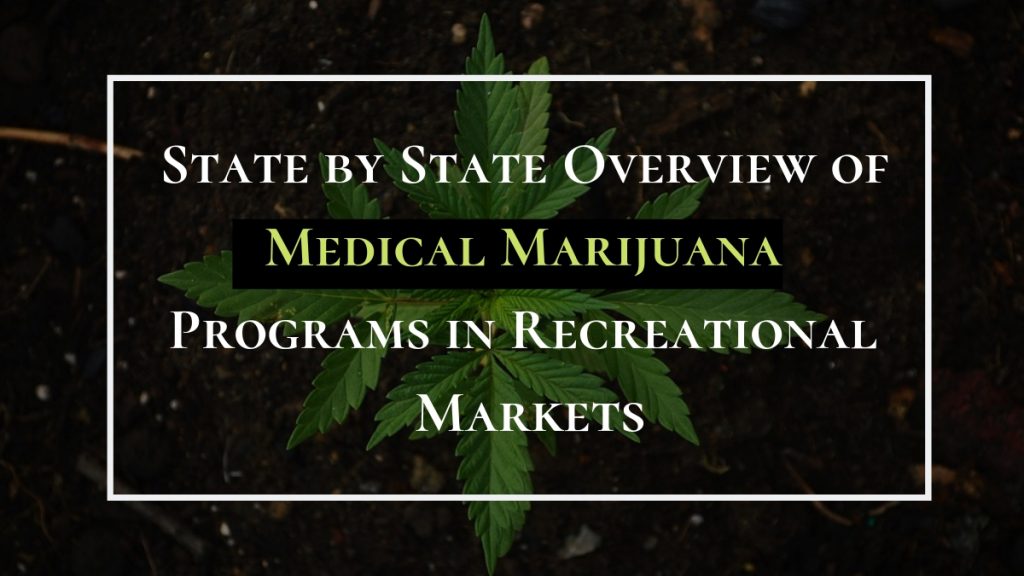The spread of medical marijuana across the country truly could not have been imagined 22 years ago when California became the first state to legalize cannabis for medical reasons. Since then, we’ve seen over 30 states follow suit with other states implementing solutions to allow for hemp or CBD products. This exciting change has given rise to a patchwork of regulations though, with each state passing their own rules to govern the emerging cannabis industry. This has created a huge variety in the types of medical marijuana programs citizens can access across America. We’ve separated these vast differences into a few easy to digest segments, ranging in regulatory severity. We will then take a brief overview of the most expansive of state’s medical marijuana program as it stands toward the end of 2018.
Recreational & Medical Programs
These state programs are the most advanced in their efforts to end cannabis prohibition and allow safe access to patients and consumers across their states. Of these locations, Alaska is the one exception across the board with no medical marijuana program but did implement recreational cannabis sales after a 2014 ballot initiative. The other states in the country tend to follow a pattern where medical marijuana is legalized and regulated prior to adult-use cannabis being considered. Most of these medical programs are therefore some of the most progressive in the nation, in terms of the medical conditions they allow, types of products in the market, and the amount of tax revenue generated for the state by these programs.
1. Washington Medical Marijuana
The state of Washington became one of two states to first legalize adult-use cannabis after putting it to a public vote in the 2012 election. Their medical program was started in 1998, only a couple short years after California became the first state to legalize medical marijuana in America. The qualifying conditions in Washington for medical marijuana include a robust list such as cancer, epilepsy, glaucoma, Crohn’s disease, intractable pain and a couple other “debilitating medical conditions.”
The medical program in Washington can be seen as one of the most robust in America. The state allows businesses to sell a great variety of products as well including cannabis flower, concentrated products, edibles, and alternative products such as lotions, suppositories, and capsules. Further, the state taxes cannabis at a rate of 37%. This is one of the highest cannabis tax rates in the country and has helped the state bring in over $315,000,000 in tax revenue (note, the state does include recreational cannabis in this number). All and all presenting a very strong program for the west coast state of Washington.
2. Oregon Medical Marijuana
Interestingly Oregon was the first state in the country to decriminalize the substance back in 1973. With this, Oregon became one of the early west coast adopters of medical marijuana, having started their program in 1998. Further, the state of Oregon has an expansive list of qualifying medical conditions to access medical marijuana which include a pretty standard list as seen from Washington. Different though is the tax rate which sits at 0% for the medical marijuana program, yet the state has generated some money through other means. Oregon sees a small amount of revenue come in for business licensing fees to support the state’s regulatory oversight program for medical marijuana.
3. California Medical Marijuana
California made history in 1996 when the citizens of The Golden State passed a vote to legalize the medicinal use of marijuana with now-famous Proposition 215. The state has also passed regulations for the adult-use of recreational cannabis during the 2016 election. California has one of the most open medical marijuana programs in the country. For example, patients can meet with a doctor over a webcam to secure a medical marijuana card! The state does not tax medical marijuana and thus has only seen a small bump in revenue through business permits and licensing fees. Finally, the state also does not restrict any cannabis-derived products from being sold in the market which allows access to edibles, extracts, and other unique cannabis goods for patients.
4. Nevada Medical Marijuana
The state of Nevada started its medical program in 2000 with the passage of a ballot initiative. The process was delayed for some time though due to regulatory burdens which only allowed private and home cultivation operations. Only to be removed after a lawsuit from a Las Vegas resident which in 2013 helped ushered in a medical marijuana infrastructure. The state does have an extra 2% tax for medical cannabis. With the help of adult-use cannabis, Nevada saw a nice $69.8 million in marijuana tax revenue during the first year of operation. The list of conditions is fairly standard for issuing a medical marijuana card including Aids, Cancer, Glaucoma, PTSD, and other severe conditions. Furthermore, the Nevada market is open to any cannabis product and does not have any major limitations to access products.
5. Colorado
Colorado, also one of the first of two states to legalize adult-use cannabis in 2012, started its medical marijuana program in 2000 which allowed card-holding patients to carry up to 2 ounces of flower. Further, the state of Colorado today has one of the most expansive medical conditions which qualify a patient to the program. Recently, the state allowed for the addition of PTSD to the qualification list, which was contested heavily before being added. The state does not tax medical marijuana any extra than other products with sales tax. The state’s also garnished huge rewards in terms of tax revenue, after legalizing cannabis for adult-use Colorado brought in $247 million in cannabis taxes, fees, and licensing.
6. Michigan Medical Marijuana
Michigan has created one of the largest medical marijuana programs in the country with over 100,000 registered patients in the state. The program started in 2008 with the passage of a ballot initiative, opening the way for an expansive medical marijuana program. The state of Michigan allows for a great variety of medical ailments to qualify for a medical marijuana card including chronic pain, nausea, epilepsy, PTSD, and many others. The state of Michigan has a fairly reasonable tax on cannabis set at 6% with an excise tax of 3% for dispensaries. This helped the state see approximately $74 million in 2017 from their medical marijuana program alone.
7. Vermont Medical Marijuana
Vermont started their medical marijuana program with approval through the state legislature in 2004. Despite opposition from the Governor at the time, the state legislature pushed the law through without his signature. Like many other states on this list, Vermont allows for a great number of medical ailments to qualify someone for the medical marijuana program. Furthermore, the state made a decision not to subject cannabis sales to state sales tax.
8. Massachusetts Medical Marijuana
The state of Massachusetts started their program in 2012 with a 63% public vote in favor of a medical marijuana ballot initiative. In a similar move to Vermont, the state does not subject medical marijuana to state sales tax. Furthermore, the state also has a fairly inclusive list of qualifying medical conditions to access the program. Yet, the program does restrict users with PTSD and severe pain from accessing the program.
9. Maine Medical Marijuana
Maine’s medical marijuana program started in 1999 when 62% of citizens voted to pass the ballot initiative. The program allows for home cultivation and patients to carry up to 2.5 ounces of medical marijuana. It also supports a traditional approach to qualifying conditions as well as products available for sale on the marketplace. Further, the Maine medical marijuana program does not have any noteworthy restrictions on cannabis products in which a dispensary may sell to patients.
10. District of Columbia Medical Marijuana
An interesting program, which was voted into effect in 1998 but was stifled by the national congress through the passage of the Barr Amendment, stopping funding from going to the program. This was the case until a 2009 court ruling struck down the law and opened up the way for medical marijuana sales. The District does tax medical marijuana at a rate of 5.75%, the normal sales tax in D.C. Finally, the rules in D.C. allow for any condition to qualify for medical marijuana if it is approved by a patient’s physician.
Expansive Medical Marijuana
The following state programs are fairly advanced in their efforts to end cannabis prohibition and allow safe access for patients across their states. However, adult-use of recreational cannabis is still restricted in these marketplaces. While some of these states have an immense investment already in their medical marijuana programs, many have a ways to go, especially the two most recent states to join as of the 2018 election, Missouri and Utah. These 23 states include the following: Hawaii, Montana, Arizona, New Mexico, North Dakota, Minnesota, Missouri, Arkansas, Louisiana, Illinois, Florida, Ohio, West Virginia, Pennsylvania, Maryland, Delaware, New Jersey, New York, Connecticut, Rhode Island, New Hampshire, Utah, Oklahoma
Limited Medical Cannabis Policies
These 11 states have existing programs but are often limited through approved medical conditions or other restrictions. Further, many of these states restrict the cannabis products to CBD only or hemp-based to qualify for the market.
- Wyoming
- Texas
- Iowa
- Indiana
- Kentucky
- Tennessee
- Alabama
- Mississippi
- Georgia
- South Carolina
- North Carolina
- Virginia
- No Cannabis Programs
Only five states remain without any pro-cannabis legislation on the books. These are Idaho, Kansas, Nebraska, South Dakota, and Wisconsin. While minor steps have been taken in some of these states, progress has been slow. Take Kansas and Wisconsin for example, where the government has approved a bill for the possession and retail sale of CBD containing no THC. In Wisconsin, this CBD regulations passed with the additional requirement of a prescription from a doctor but still is a small step in the right direction regarding cannabis regulation. The others on the list continue to be stifled with progressive cannabis regulations passing due to a variety of political reasons. For example, a strictly socially conservative pollution denying the referendum, as is the case in South Dakota. While in Idaho the Governor has vetoed a CBD oil bill while making “it clear he does not support cannabis.”

